You Should Get Into Hairy Situations On The River
Published:
August 18th, 2016
By:
Josh Sheldon

Most rivers have monsters lurking around almost every bend. I say, get a bit hairy and go toe to toe with them.
Although there are many hidden dangers in a river, that’s not the kind of monster we will be attacking this week. I have spent many hours on the Chenango and find it a challenging place to fish to say the least. You have all of the same variables that pertain to lakes, but then to have to deal with current and, in many cases, fishing from a moving platform. Add to that countless snags and overhanging vegetation, you may find yourself headed for some flat water or the bait shop for more tackle in no time. Instead of letting it get me down over the years, I have stuck with it and learned a few secrets along the way that keep me coming back for more.
Let’s face it; river fishing isn’t for the impatient, weak or faint of heart. You need to have a lot of knowledge and have all the gear to be regularly successful. Most people won’t spend enough time to learn the secrets. One of the biggest secrets is to know your run, and if you don’t, ask anyone who has the most recent information. Every strip of river is subject to change with a heavy storm. You also need to know how long an average float takes going down a run and add a significant amount of time for fishing. It really stinks to be stuck out there after the sun sets and realize you are now on the menu. Mosquitos will absolutely mob you if you don’t have a bug suit or some kind of quality repellant. Don’t forget food and water; and it’s not a bad idea to take some meds with you, such as some pain reliever and antihistamine, as you never know when a splitting headache, accident or sting will happen. Take more water than you think you’ll need and I would recommend some sunscreen if you will be out in the direct sunlight for any length of time. After the life preserver, rod, bait and boat plug are all checked off the list you can finally head out.
Now that you are finally on the water, what line and bait should you choose? Over the years, I have found that super lines, like braids or fused, outperform monofilament or fluorocarbon, hands down. The added breaking strength helps you free your bait from snags most times by either pulling it in to you or pulling yourself in to it. There are so many chances to get snagged, that the ability to retrieve lost bait is of utmost importance. They make several types of lure retrievers, but I just get them the old way if I can. I reel myself to the snag or paddle to or past it a bit if there is current and reel the line up until the tip of the rod engages the bait. I then give a fast downward jab and typically the bait will be dislodged and sitting at the end of your rod. The downside is that these lines will cut the heck out of you and they have no stretch. Never pull by the line as it will saw its way into your skin as deep as you let it, especially if your hands are wet, and they are most of the time on the river. As for bait, that can be a bit tricky.
Live bait works well from shore but isn’t really good while on the move. I find in most cases light lures tend to drift too fast and don’t work as well as heavier baits. I find that jigs work great, especially the heavier ones, because they hit the bottom and slow down. This allows the bait to remain in a fish’s striking zone for a much longer time, which increases your odds of getting a bite. The problem with jigs is they are snag magnets. Most wooden debris ends up on the bottom after becoming waterlogged and rocks also pose a snagging risk. For this reason, I started making my own. I decided to go old-school and mix in a bit of new to create cheap and effective baits.
I tie flies, so I already had all the equipment to tie jigs but didn’t know what to make them look like. It didn’t take me long to look at all the crayfish on the bottom and decide to mimic them as close as possible. I tied a few and on my first and second cast I got a bite. I hooked and landed a fish on the second cast which spit up a crayfish that looked almost identical to my jig in the water. I caught many more that day but the next trop was all the proof I needed. It was a muddy water day and again on my first cast I hooked and landed another Smallmouth Bass. I noticed the hair on the jig was making the hook stay off the bottom which prevented snags and kept it upright to give the best hooking opportunity possible.
Hey and if all else fails at least you get to enjoy a beautiful trip down the river. Don’t think I’m going to show off my secret weapons, but am happy to share the beautiful sunset and rainbow I saw on my last trip.
Good wishes and make a few baits of your own, they may surprise you.
Author: Josh Sheldon - More From This Author
Comments









